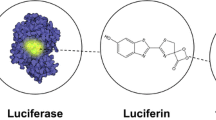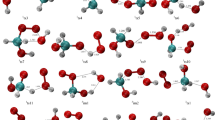Abstract
The mechanism of aniline oxidation by singlet oxygen was studied by the DFT-PBE/L2 method. According to the calculations, aniline endoperoxide cannot participate in the reaction because of its energy instability. The addition of 1O2 to aniline proceeds with the simultaneous proton transfer to the oxygen molecule from the NH2 group (for the syn-approach of oxygen) or from the aromatic ring (for the anti-approach). For the syn-approach of the 1O2 molecule, the HNC6H4(H)OOH intermediate is formed, whose decomposition leads to aniline p-hydroperoxide (predominantly) or p-iminoquinone. In the case of the anti-approach, the 1O2 molecule is inserted at the C–H bond to form aniline p-hydroperoxide (H2NC6H4OOH). The decomposition of aniline p-hydroperoxide with the formation of p-aminophenol and H2O2 molecule proceeds via concerted mechanism.
Similar content being viewed by others
References
Patent RF No. 2567552; Byul. Izobr. [Invention Bulletin], 2015, 31 (in Russian).
T. M. Fedorova, L. I. Solovyova, E. N. Shevchenko, A. V. Butenin, E. A. Lukyanets, O. L. Kaliya, Tez. Dokl. III Ross. Kongressa po katalizu "ROSKATALIZ" [Proc. III Russ. Congress on Catalysis "ROSKATALIZ"] (Nizhny Novgorod, May 22–26, 2017), Novosibirsk, Institute of Catalysis, Siberian Branch of the Russian Academy of Sciences, 2017, p. 588 (in Russian).
N. A. Kuznetsova, T. M. Fedorova, L. I. Solovyova, E. N. Shevchenko, E. B. Bordaev, R. A. Bulgakov, O. L. Kaliya, E. A. Lukyanets, Macroheterocycles, 2018, 11,21.
S. H. Chien, M. F. Cheng, K. C. Lau, W. K. Li, J. Phys. Chem. A, 2005, 109, 7509.
J. Al-Nu’airat, M. Altarawneh, X. Gao, P. R. Wetsmoreland, B. Z. Dlugogorski, J. Phys. Chem. A, 2017, 121, 3109.
K. Briviba, T. P. A. Devasagayam, H. Sies, S. Stnken, Chem. Res. Toxicol., 1993, 6,548.
D. N. Laikov, Chem. Phys. Lett., 1997, 281,151.
D. N. Laikov, Yu. A. Ustynyuk, Russ. Chem. Bull., 2005, 54,820.
J. P. Perdew, K. Burke, M. Ernzerhof, Phys. Rev. Lett., 1996, 77, 3865.
D. N. Laikov, Chem. Phys. Lett., 2005, 416,116.
L. G. Gagliardi, C. B. Castells, C. Ràfols, M. Rosés, E. Bosch, J. Chem. Eng. Data, 2007, 52, 1103.
K. Yamaguchi, F. Jensen, A. Dorigo, K. N. Houk, Chem. Phys. Lett., 1988, 149,537.
T. Saito, S. Nishihara, Y. Katayoka, Y. Nikanishi, T. Matsui, Y. Kitagawa, T. Kawakami, M. Okumura, K. Yamaguchi, Chem. Phys. Lett., 2009, 483,168.
E. Lissi, M. Encinas, E. Lemp, M. Rubio, Chem. Rev., 1993, 93,699.
I. Saito, T. Matsura, K. Inoue, J. Am. Chem. Soc., 1981, 103,188.
M. Schäfer-Ridder, U. Brocker, E. Vogel, Angew. Chem., Int. Ed. Engl., 1976, 15,228.
N. Turro, M. F. Chow, J. Am. Chem. Soc., 1981, 103, 7218.
Author information
Authors and Affiliations
Corresponding author
Additional information
Published in Russian in Izvestiya Akademii Nauk. Seriya Khimicheskaya, No. 9, pp. 1567–1572, September, 2018.
Rights and permissions
About this article
Cite this article
Shamsiev, R.S., Kaliya, O.L. & Flid, V.R. Theoretical modeling of the mechanism of aniline oxidation by singlet O2. Russ Chem Bull 67, 1567–1572 (2018). https://doi.org/10.1007/s11172-018-2259-4
Received:
Accepted:
Published:
Issue Date:
DOI: https://doi.org/10.1007/s11172-018-2259-4




